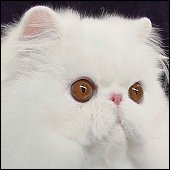
The Persian is the most popular breed of cat in the world - and one of the oldest. As their name suggests, Persians originate from the country that was once Persia, now Iran, in the Middle East. Its long coat was most likely a mutation which came about naturally to deal with cold weather. Originally called a Longhair the Persian first was noticed in Europe in the 1600's. It is thought that this was the first registered and shown cat breed. They were called Longhairs until the l960's in the U.S. In Britain the are still using the name Longhairs and each color variety is treated as a separate breed. The Persian cat of today is the result of crossing the Angora and the Maine Coon.
"The ideal Persian should present an impression of a heavily boned, well balanced cat with a sweet expression and soft, round lines. The large round eyes set wide apart in a large round head contribute to the overall look and expression. The long thick coat softens the lines of the cat and accentuates the roundness in appearance."
The Cat Fanciers Association Breed Statement
Medium to large in size is what to look for in a Persian cat. The body is stocky and wide sitting low on its legs. The legs are heavily boned, short, heavy and straight. The coat is very thick and can be as much a 6 inches long. It is double very heavy and lively. This cat requires a great deal of grooming. Daily combing or brushing with a metal toothed comb or a natural bristle brush or a brush with wires is necessary. This cat sheds year round and dead hair must be combed or brushed out daily to avoid hairballs and matting.
Tips on cleaning persian kitty ears :
Clean ears with a cotton ball or Q-Tip, but only clean out what you can see! Never enter the ear canal, leave that to the vet! Do ears after the bath. Be careful not to allow water from the bath into the ears, and cautiously around the mouth and nose not to drown your Persian kitty.
The color varieties in Britain each have their own standards where as in the United States all Persians, regardless of color, must vie to the same exact standards. This makes breeding difficult in that producing a silver Persian with the same head type and ears as most of the other color varieties is not easy. Persians are divided by color and then separated again into divisions into which most of the colors appear. The divisions incorporate the solid, shaded silvers, shaded goldens, cameos, and chinchillas.
Eyes in Persians:
Yes they water and even in a rust color in some localities! It is because of the breeding of extremeness. Please wash your Persian face daily and cautiously. Select a routine time to clean the face and groom the kitten. Don't allow the eyes to become infected by not cleaning them regularly. I also have an article on the grooming page to help with eye stains and cleaning them. I suggest a boric acid wash each day esp on the bi-color persian faces. We mix this 1 tablespoon of boric acid powder to 12 oz of boiling water. Keep this container sealed and apply on a makeup pad to clean the face, each wipe actually cleans even more. Then if the stain isn't washing off, apply some eye and wound powder to the fur around the bottom of the eye.
Also seen are smoke's and tabby tortoiseshell and particular or bicolor.. There are also shaded versions of the solid colors. Eyes must be copper with the exception of the silvers that have a blue green eye color and the goldens have green to hazel eyes. The Himalayan is the newest division in most cat associations. The Persian cats that are lilac point, blue point. chocolate point, seal point, red point, tortie point and lynx point are considered Himalayan. These all must have blue eyes.
 The Persian cat is a very lovable animal who is calm, and gentle. He loves to be petted and shown a lot of attention. But Persian also can take care of itself without too much entertaining by humans.
The Persian cat is a very lovable animal who is calm, and gentle. He loves to be petted and shown a lot of attention. But Persian also can take care of itself without too much entertaining by humans.